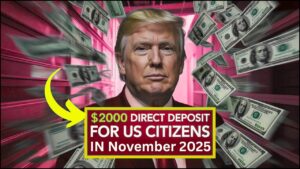Many American families are still struggling with high living expenses going into the holiday season. To offer timely financial support, the federal government is considering a $2,000 direct deposit relief payment planned for late 2025. While the proposal is awaiting final approval, agencies are preparing to distribute funds through the Internal Revenue Service (IRS) to ensure fast delivery once the program is confirmed.
The purpose of this relief payment is to provide short-term stability in an environment where rent, groceries, transportation, and healthcare costs continue to increase.
Table of Contents
$2,000 Direct Deposit for US Citizens in November 2025
The one-time $2,000 payment is intended to lighten day-to-day burdens and prevent financial setbacks. Although the payment won’t permanently solve rising living costs, it can help households pay urgent bills, cover medical needs, repair a vehicle, or manage other essentials without falling behind.
Most payments would be deposited electronically using banking information from previous tax filings. Paper checks or prepaid cards will be the alternative for recipients without bank details on file.
Eligibility Criteria
Qualification will depend on multiple factors:
- Citizenship or Legal Residency: U.S. citizens, lawful permanent residents, and qualifying resident aliens may be eligible. A valid Social Security number will be required for IRS processing.
- Income Limits Based on 2024 Tax Return:
| Filing Status | Income Limit |
|---|---|
| Single | $75,000 or less |
| Married filing jointly | $150,000 or less |
| Head of household | $112,500 or less |
Households earning above these limits may receive a reduced amount based on a phase-out formula linked to adjusted gross income (AGI).
- Dependents and Filing Status: A 2024 return must be filed for the IRS to verify family details and income. Adults claimed as dependents generally do not receive their own payment.
- Direct Deposit Information: Up-to-date banking details ensure faster payment. Incorrect or outdated account information can result in delays and may convert the payment to a check or prepaid card.
Expected Payment Timeline in November 2025
The IRS typically processes relief in groups rather than all at once. Based on past federal rollout schedules, payments may follow this estimated timeline:
| Phase | Estimated Payment Window | Group Receiving Payment |
|---|---|---|
| Phase 1 | November 10–15, 2025 | Direct deposits for taxpayers with verified bank information |
| Phase 2 | November 18–25, 2025 | Direct deposits requiring minor account/address updates |
| Phase 3 | Late November – Mid December 2025 | Paper checks and prepaid debit cards |
Most eligible recipients with correct banking details should receive funds between November 10 and November 25, 2025.
IRS Steps to Ensure Your Payment Arrives on Time
- File your 2024 federal tax return, even if you missed the original deadline.
- Sign in to your IRS online account and verify your bank routing and account numbers.
- Update your mailing address as backup delivery information.
- Respond quickly to any identity verification or tax notice letters.
- Use the payment status tracking tool if the IRS releases one for this program.
If the payment does not arrive within the stated timeline, individuals can request a payment trace, check whether their bank rejected the deposit, or claim the Recovery Rebate Credit on their 2025 return if eligible funds were never received.
Important Things to Know
- Relief payments are typically not counted as taxable income and do not reduce federal tax refunds.
- Income changes in 2025 generally will not affect eligibility, as decisions are based on 2024 returns.
- Beneficiaries of Social Security, SSI, SSDI, and VA programs may qualify as long as they meet income limits and are not claimed as dependents.
- Households with mixed immigration statuses may experience partial eligibility and should ensure dependents and SSN/ITIN information are correctly reported.
Smart Ways to Use the Payment
Planning ahead can maximize the benefit of the $2,000 relief deposit. Families are advised to rank bills by urgency such as housing payments, utilities, transportation, groceries, and insurance. Using part of the payment to reduce high-interest credit card balances can also relieve long-term financial pressure. Preventive expenses—like vehicle maintenance or heating system servicing—can stop bigger financial emergencies later.
FAQs
Q1: Is the $2,000 direct deposit confirmed?
A1: No, it is still pending final federal approval but preparations are underway for fast rollout.
Q2: Will paper checks be available for people without direct deposit?
A2: Yes, but they may take longer than bank deposits.
Q3: Are these payments taxable?
A3: Typically no, federal relief payments are not counted as taxable income.








